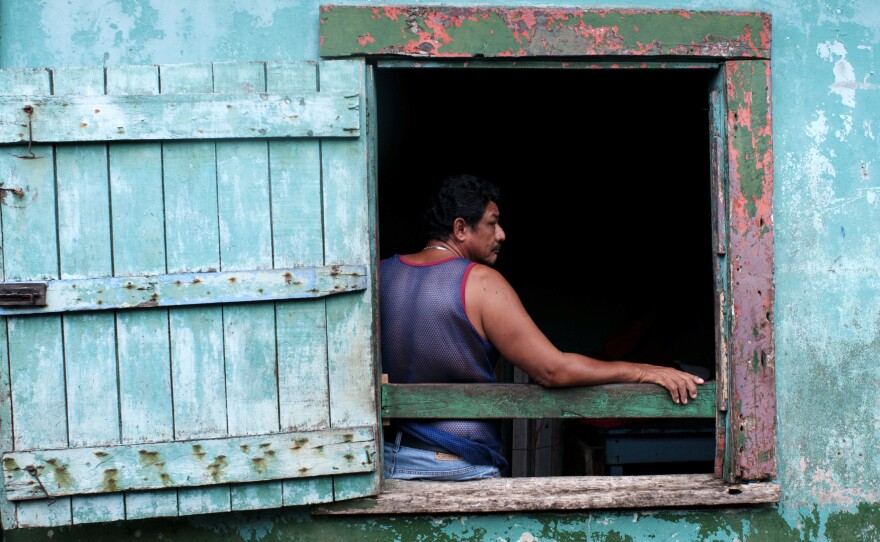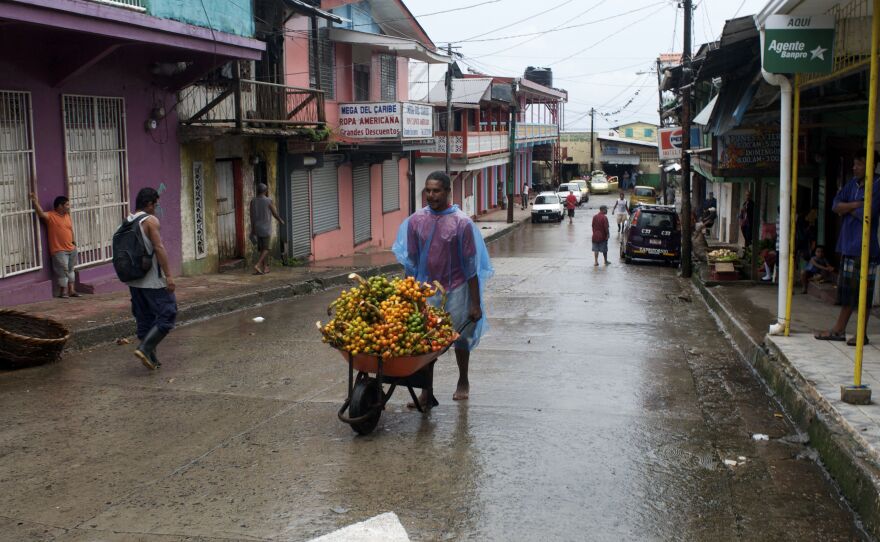
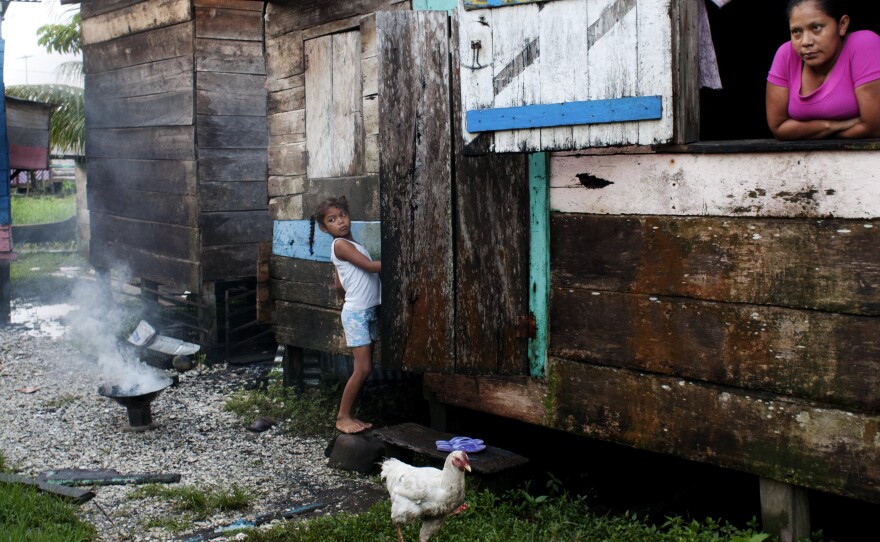
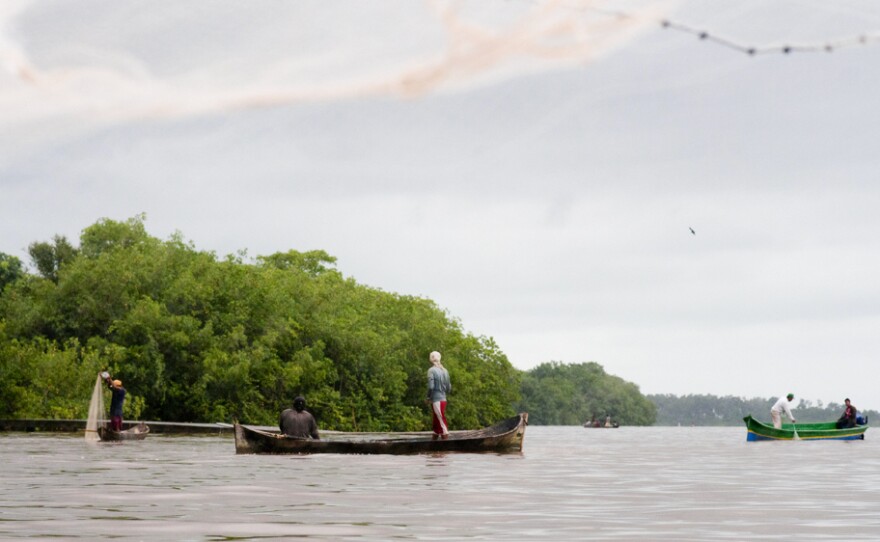
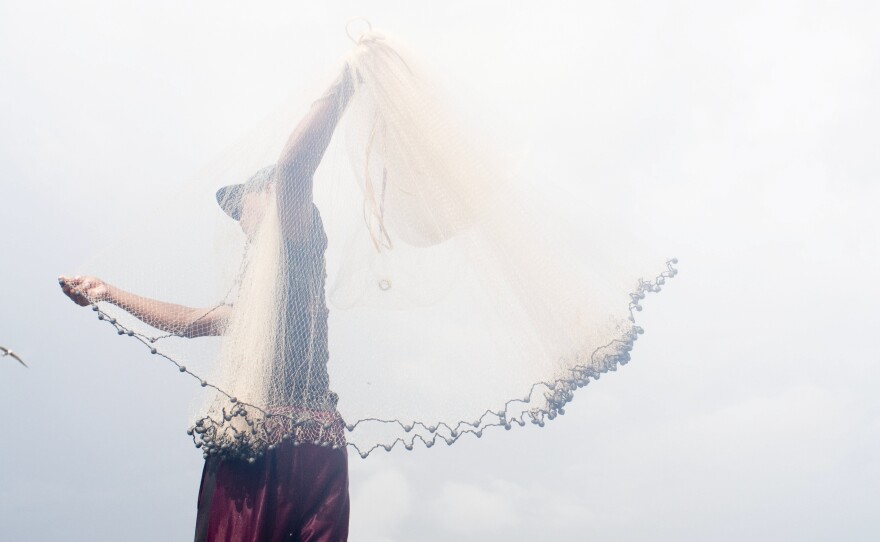
Back in the day, the city of Bluefields inspired poets. In truth, it should be paradise, because it sits in an enviable position along Nicaragua's Caribbean coast.
But as history unfolded, Bluefields became a forgotten city, cut off from the rest of the country by a vast jungle and different culture. As you walk its main street, you feel a struggle: Utility cables crisscross the streets, framing buildings, making them look like they're sagging under the weight of history. It rains so much that when paint peels off a piece of concrete, it doesn't take long for moss to set in. And no matter where you are, you're hit by the stench of open sewers.
Eight out of 10 people in this city are unemployed, yet there are stores everywhere and business seems brisk.
Roberto Campbell, a storekeeper who's hanging out on a wooden cart, says this place depends fully on the the drug trade.
"It's not no secret. Everybody knows that," he says in English. "The big businesses from here, if there are no drugs around, they cannot sell their articles. So when you see things are good, that means drugs are around."
The drug trade is this city's blessing and its curse. It's a city that's part of a country that has managed to remain relatively peaceful despite being in one of the most dangerous regions in the world. Analysts say one of the explanations for that relative peace is that Nicaragua has taken a different approach to fighting drug trafficking.
Whether by circumstance or choice, it has foregone its neighbors' military approach for a less confrontational — and some would say more opportunistic — strategy. It's an approach that has helped the country avoid the kind of violence that makes international headlines, but also suggests an uncomfortably close relationship between the people, the government and the drug dealers.
Back in 2012, the citizens of Bluefields took to the streets to protest the arrest of a notorious kingpin. News footage showed hundreds of people marching around demanding "justice" and "freedom." The government alleged that Ted Hayman was involved in the drug trade, so they confiscated his home — a huge, gaudy structure in the hills surrounding Bluefields.
Donald Byers, who runs a museum about this region's history, says Hayman was Bluefields' Pablo Escobar, the Colombian drug lord who pumped his drug money into his hometown economy. There were entire neighborhoods that were on Hayman's payroll, so when he and a couple dozen of his deputies were imprisoned, the economy essentially collapsed.
"That Christmas you could feel Bluefields wasn't the Bluefields that I know," Byers says. "You could feel a big difference. You could see a lot of people with no work on the street. People were complaining, 'This damn government. It's just messing up. They don't give us work. This guy came and give us work and now they put him in jail.'"
Byers says when the clock struck midnight and Christmas Eve turned into Christmas, there were no fireworks like previous years. Instead, it was quiet; it was sad.
The Management Of Crime
On the surface, it seems like the Nicaraguan government is doing quite a bit to fight the drug war and that Bluefields is a place of perdition.
But reality is more complicated.
Nicaragua — the largest country in Central America — has a lengthy coastline on the Pacific Ocean and the Caribbean Sea. With its remote location, Bluefields is well placed to serve as a pit stop along the corridor where drugs travel from the South American producers to U.S. consumers.
What's more, the cocaine moving through Nicaragua's territory represents a higher share of GDP than any other Central American country, which in the words of the U.N.'s Office on Drugs and Crime, should give traffickers greater leverage to both sow more corruption and foment violence.
Instead, like the rest of Nicaragua, Bluefields is an outlier. For instance, its murder rate is relatively low. According to numbers compiled by the Mexican think tank The Citizen Council for Public Security and Penal Justice, San Pedro Sula in Honduras is the murder capital of the world with a homicide rate of 169 intentional homicides per 100,000 people; Belize City has a murder rate of 105. According to Nicaraguan government data, Bluefields has a homicide rate of 42 — just a touch lower than that of Detroit.
Before, 2006, when Mexico's former President Felipe Calderón declared a war on drugs, none of this mattered. But as Mexico squeezed its cartels at home, the violence moved south in a big way, transforming Central America from a passive transit route to a central theater in the war on drugs.
Honduras, El Salvador, Guatemala and Belize responded by fighting fire with fire, militarizing their response with funding and training from United States, under a new scheme called the Central American Regional Security Initiative (CARSI).
Nicaragua, partly because of its cold relationship with the United States, was mostly shut out of that funding and chose a different path.
In private, government officials will tell you that Nicaragua does what it can. It goes after local kingpins like Hayman, because it doesn't have the navy or air force to go after the big drug dealers that are inevitably moving large amounts of drugs across Nicaraguan territory.
Roberto Orozco, an expert on Nicaraguan security, believes, however, that this is a deliberate strategy.
"Nicaragua administers, manages its organized crime," Orozco says.
He says that countries like Honduras and Guatemala have at different points tried to do the same thing, but there is one huge difference: In Nicaragua, there is no turf war.
"Because in Nicaragua, there is only one mafia," Orozco says. "And that mafia controls the entire national territory."
When asked who that mafia is, Orozco laughs nervously, delivering a roundabout answer before finally saying, "When I say that Nicaragua manages organized crime, I mean that the business deals are made with representatives from the state."
In other words, Nicaragua essentially regulates the drug trade.
Jose Miguel Cruz, a professor at Florida International University who wrote his dissertation on what he calls "Nicaraguan exceptionalism" in matters of security, explains it like this: "People in the government know that the drugs are crossing there. But as long as they don't generate too much violence and too much conflict and disrupt the social order, they can just pass."
Cruz says that explanation makes sense, but there is no smoking gun to point to that kind of relationship between Nicaragua and the cartels.
Two members of the Nicaraguan government denied those kinds of allegations in interviews. But they're also not new. The United States Embassy in Managua made much the same claims in a secret 2006 diplomatic cable published by WikiLeaks.
The cable alleges that President Daniel Ortega and his party used money from international drug traffickers to finance political campaigns. As the U.S. cable explains, it's a relationship that dates back to the '80s, when Ortega cut a transit deal with Pablo Escobar. The Drug Enforcement Agency placed hidden cameras on one of Escobar's planes and they caught high-ranking Nicaraguan officials loading cocaine onto the aircraft.
When pressed, Jacinto Suarez, the governing party's international secretary, laughs off the allegations and points out that Nicaragua seizes tons of cocaine each year.
Then, growing angry, he says if the world wanted to fix the drug problem, the United States should look to its own people first.
"We're the ones dealing with all of the dead people and all of the fighting, yet the consumers, the ones who provoke the phenomenon, are the ones who also decide who is doing a good job combating drugs," Suarez says. "That's why, some leaders have said, 'Let's legalize this and let the drugs flow north. Because if we don't, the gringos are going to keep swallowing drugs, while we kill each other.'"
Pirates Prowl For 'White Lobsters'
The small wooden boats start heading out to Bluefields Bay even before the sun rises. As it peaks from the horizon, the water is dotted with men trying their luck on the ocean.
José Raúl Sánchez, a 36-year-old fisherman who has spent most of his life out at sea, says he's out here nearly every day. He says he's had opportunities to make money from the drug trade, but he's never done so. People will kill you for a kilo, he says.
On the other side of Sanchez's boat, his nephew gathers a net. The lead weights drag against bottom of the boat. Slowly, with the patience and skill of an old lady praying a rosary, he runs the net through his fingers, putting part of it in his mouth. Then, with a single movement, he throws. Out here, it's so quiet you can hear the nylon cut through the air.
Suddenly, past the mangroves, in the expanse of open ocean, we hear the roar of big engines.
Sanchez says those are the pirates, the guys on bigger boats who go looking for "white lobsters," or kilos of cocaine thrown overboard by drug traffickers trying to escape from authorities. He says when the pirates get their hands on a packet, whole neighborhoods benefit.
It presents a stark choice to all of Bluefields: embrace the drug trade or live in deep poverty.
Sanchez says he's seen the damage that drugs have caused young people, so he decides to stay above the fray. "I have a son, and I would not want him involved in that," he says.
In a lot of ways, the Nicaraguan government faces some of the same tough choices: Take on the drug trade with military might the way Honduras and El Salvador have done and risk greater violence, or accept corruption and allow the drug trade to operate.
As Orozco, the Nicaraguan security expert, sees it, the government has chosen the "lesser of two evils."
The government's approach "is much better, because we avoid the kind of extravagant crime you see in places like Mexico," he says, "where they hang a dozen people off an overpass."
To some extent, the kind of policies Nicaragua has chosen have started to gain traction internationally.
In 2011, The Global Commission on Drugs, a high-profile panel of world leaders – including former U.N. Secretary-General Kofi Annan and former U.S. Federal Reserve Chairman Paul Volcker — declared that the "global war on drugs has failed." And this September, the commission followed up with a report recommending policies that work, including some legalization and encouraging countries to try regulating instead of prohibiting some aspects of the drug trade.
Orozco worries, however, that Nicaragua's relative peace is tenuous. The economic incentive for cartels to control this territory is huge. So how long, he asks, will it be before the Nicaraguan government's sole control is challenged by a well-heeled, well-armed cartel with little to lose?
This story was funded with a grant from the Ford Foundation, administered by the International Center for Journalists.
Copyright 2014 NPR. To see more, visit http://www.npr.org/.


